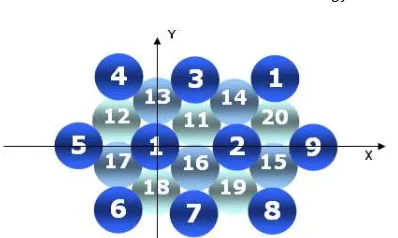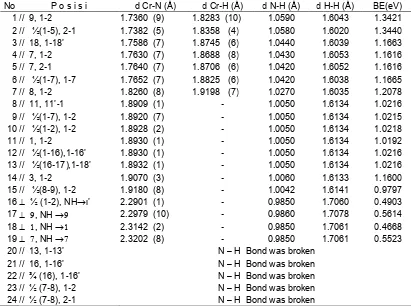Indo. J. Chem., 2010, 10 (1), 102 - 105
Charles Banon
102
* Corresponding author. Tel/Fax : +62-0736 20919 Email address : [email protected]
** Postgraduate Student of Chemistry Department, Faculty of Mathematic and Natural Sciences, Universitas Gadjah Mada
ADSORPTION OF AN NH
3MOLECULE ON Cr(111) SURFACE BY QCMP 116 PROGRAM
Charles Banon
*.**Department of Chemistry, University of Bengkulu, Jl. WR. Supratman Kandang Limun Bengkulu, Indonesia
Received December 11, 2009; Accepted March 30, 2010
ABSTRACT
Interactions of an NH3 molecule on chromium (111) surface consists of 20 atoms with three layers has been
studied by QCMP 116 (Calzaferri) program, run on IBM PC compatible (Pentium III, 660 MHz). An oncoming NH3
(with the planar molecular plane parallel or perpendicular to surface), at many positions, was optimized three dimensionally by that program. Observing the binding energy of an NH3 on surface (BE (NH3)) and inter atomic
distances at the optimized conditions. It’s showed that: an oncoming NH3molecule, with molecular plane parallel to
the surface, N atom was oriented to atoms of the first and third layer. One of its NH bond was parallel to the Cr–Cr bond were chemisorbed molecularly with BE(NH3) in range of 0.9797-1.3421 eV/molecule. On the second layer was
chemisorbed atomically. However, an oncoming NH3with molecular plane perpendicular to the surface (with N atom
and one of its N–H bond perpendicular to Cr atom) was adsorbed physically with BE(NH3) in a range of
0.4903-0.5614 eV/molecule.
Keywords: adsorption, binding energy
INTRODUCTION
Catalyst plays an important role in the ammonia synthesis from N2and H2 gases. Iron has been used as a catalyst in an industry of ammonia with an yield of 20%. Many investigations had been done to increase this yield. Norskov and Stoltze [1] reported that N2 was adsorbed atomically to iron surface, followed by reaction to H2 gas produced the adsorbed ammonia and then desorption of ammonia. The activity of iron catalyst depends strongly on structure of iron surface. The Fe(111) surface is highly active, about 25 and 400 times as active as the Fe(100) and Fe(110) surface, at 200 atm and 525 °C [2], respectively. Dowbenet al. [3] found that N2 was adsorbed molecularly and atomically on Cr (110) surface. This is not surprising, since both Fe and Cr have the same crystal structure e.i bcc with ao (lattice parameter) 2.78 and 2.88 Å, respectively. Kusuma [4] also found that N2was adsorbed atomically on Fe (111), Fe/Cr(111) (alloy Fe-Cr), and Cr(111).
The aim of this investigation is to study the BE(NH3) on the Cr(111) surface. It was defined that the binding energy of NH3 on the surface as (BE(NH3)). The surface to be used in these calculations consists of 20 atoms. 10 atoms on the first layer, five atoms on the second and on the third layer (Fig. 1). Then an NH3with molecular plane parallel (NH3parallel) and perpendicular (NH3 perpendicular) to surface, at many positions, comes to the surface. The process that happened for adsorption was investigated by three dimensional (3D) optimization on QCMP 116 program, run on IBM PC compatible (Pentium III), with accuracy 0.00001 eV. In
this calculations, an NH3 molecule was assumed to be planar with d(N-H) = 0.992 Å, andHNH = 120° (D3h).
EXPERIMENTAL SECTION
Materials and Instrumentation
This experiment is Cr (111) surface consists of 20 atoms with three layers. An oncoming NH3 (with the planar molecular plane parallel or perpendicular to surface) has been studied by QCMP 116 (Calzaferri) program, run on IBM PC compatible (Pentium III, 660 MHz).
Procedure
Formerly EHMO method worked on mainframe. In order to get more applications, this program was modified as ASED program (work on surface chemistry), and QCMP 116 program (adopted for studying inorganic compound) [5]. In this investigation, the QCMP 116 program was used to study the interaction of gases on a surface. For that propose, some of its atomic parameters were modified.
Indo. J. Chem., 2010, 10 (1), 102 - 105
Charles Banon
103
Table 1.The parameter used in the present calculations
Atom ns s VSIE(eV) np p VSIE(eV) nd 1 VSIE(eV) 2 C1 C2
Cr 4 1.600 -6.77 4 1.30 -3.72 3 4.95 -9.50 1.60 0.4876 0.7205
N 2 2.140 -26.0 2 1.95 -13.4
H 1 1.300 -12.6
VSIE = Valence State Ionization Energy
Fig 1. Cr(111) surface, 1-10: first layer; 13-17: second layer; 11, 12, 18-20: third layer
coefficient orbital exponent (C1 and C2). Parameters used in these calculations were listed in Table 1. Parameters for N atom were taken from the program while for Cr and H was modified by Kusuma [6]. The coordinate to be used in these calculations was internal coordinate.
Outputs of this program are the total energy of system (ET in eV), and distance matrices that give information about inter atomic distance (d in Å), overlap population matrices, that reflect the strength of inter atomic bond, etc. Detail about the program is written in the manual of the program (Calzaferri and Brandle) [5].
The surface to be studied was shown in Fig. 1. The N atom of the NH3parallel was oriented to atoms of the surface and one of its N–H bond was parallel to the Cr–Cr bond. Those were atoms No 1, 2 (in the surface site); No 3, 7, 8, 9 (in the edge site) both with d(Cr-N) initial = 1.5 Å; No 13, 16 (in second layer), No 11, 18 (in third layer) both with d(Cr-N) initial = 1.0 Å. It also had been oriented to the middle point between two atoms with d(Cr-N) initial = 1.0 Å. Those were between atom No 1 and 2, atom No 1 and 5, atom No 1 and 7, atom No 7 and 8, atom No 8 and 9, atom No 16 and 17, and atom No 1 and 16’ (16’ was the projection of atom No 16 to the surface). On the other hand the N atom and one of N–H bond of the NH3 perpendicular was oriented to atom No 1, 7, 9, and between atom No 1 and 2 (with d(Cr-N) initial = 1.0 Å). During 3D optimization (manual) surface was assumed to be rigid. Optimization had begun with N atom followed by H atoms simultaneously. At the beginning, for each set of optimation the increment/decrement of the vector length was assumed to be 0.1 Å, while for bond angle and dihedral angle were 2°. When we got close to the optimized condition,
those values were changed to 0.001 Å and 0.05°, respectively. In same cases, to keep the NH3molecule not to leave the surface immediately, we defined that at the first step of optimation the length of vector N should not be greater than 2.200Å.
In this experiment, (d) and BE(NH3) in optimal condition were used to predict whether an NH3 molecule was adsorbed physically or chemically to surface. This was due to BE(NH3) reflected strength of surface to adsorb the NH3 molecule, indirectly the possibility of a surface to desorbed the adsorbed NH3. BE(NH3) was calculated by:
BE(NH3) = ET(surface) + ET(NH3) – ET(surface + NH3)
RESULT AND DISCUSSION
Table 2 showed the results of these calculations. An NH3 parallel usually was chemisorbed molecularly with BE(NH3) and d(Cr-N) in the ranges of 0.9797-1.3440 eV/molecule and 1.7360-1.9180 Å, respectively. For Fe(111) surface (with similar structure) those values were in the ranges of 1.9380-2.2130 eV/molecule and 1.4920-1.6390 Å [7], respectively. It might be Cr(111) desorbed the adsorbed NH3 better than Fe(111) surface.
There were two types of bonding structure of NH3 parallel on Cr(111) surface, a and b (Fig. 2). Structure b had BE(NH3) greater than a, since two atoms of the NH3 molecule were bonded to the different Cr atom of the surface. Structure b was predominantly found when the NH3 parallel was oriented to the edge of surface (Table 2. No 1, 4, 5, 7). The edge position was reactive. Some of edge positions also adsorbed NH3 with structure a with BE(NH3) less than of and d(Cr-N) greater than of structure b (Table 2. No 14, 15). Thus, edge positions were comparable with site positions (Table 2. No 10, 11 Vs 14, 15).
Indo. J. Chem., 2010, 10 (1), 102 - 105
Charles Banon
104
Table 2.BE(NH3) and internuclear distances of An NH3oncoming with molecular plane parallel and perpendicular to the Cr(111) surface at many positions.
No P o s i s i d Cr-N (Å) d Cr-H (Å) d N-H (Å) d H-H (Å) BE(eV)
1 // 9, 1-2 1.7360 (9) 1.8283 (10) 1.0590 1.6043 1.3421
2 // ½(1-5), 2-1 1.7382 (5) 1.8358 (4) 1.0580 1.6020 1.3440
3 // 18, 1-18’ 1.7586 (7) 1.8745 (6) 1.0440 1.6039 1.1663
4 // 7, 1-2 1.7630 (7) 1.8688 (8) 1.0430 1.6053 1.1616
5 // 7, 2-1 1.7640 (7) 1.8706 (6) 1.0420 1.6052 1.1616
6 // ½(1-7), 1-7 1.7652 (7) 1.8825 (6) 1.0420 1.6038 1.1665
7 // 8, 1-2 1.8260 (8) 1.9198 (7) 1.0270 1.6035 1.2078
8 // 11, 11’-1 1.8909 (1) - 1.0050 1.6134 1.0216
9 // ½(1-7), 1-2 1.8920 (7) - 1.0050 1.6134 1.0215
10 // ½(1-2), 1-2 1.8928 (2) - 1.0050 1.6134 1.0218
11 // 1, 1-2 1.8930 (1) - 1.0050 1.6134 1.0192
12 // ½(1-16),1-16’ 1.8930 (1) - 1.0050 1.6134 1.0216
13 // ½(16-17),1-18’ 1.8932 (1) - 1.0050 1.6134 1.0216
14 // 3, 1-2 1.9070 (3) - 1.0060 1.6133 1.1600
15 // ½(8-9), 1-2 1.9180 (8) - 1.0042 1.6141 0.9797
16½ (1-2), NH’ 2.2901 (1) - 0.9850 1.7060 0.4903
17 , NH 2.2979 (10) - 0.9860 1.7078 0.5614
18 , NH 2.3142 (2) - 0.9850 1.7061 0.4668
19 , NH 2.3202 (8) - 0.9850 1.7061 0.5523
20 // 13, 1-13’ N – H Bond was broken
21 // 16, 1-16’ N – H Bond was broken
22 // ¾ (16), 1-16’ N – H Bond was broken
23 // ½ (7-8), 1-2 N – H Bond was broken
24 // ½ (7-8), 2-1 N – H Bond was broken
//; means an oncoming NH3with molecular plane parallel to surface 1,1-2; an N atom on-top atom No 1 and an N-H bond parallel to 1-2 line
½(1-2); an N atom on-top in the middle atom No 1 and 2
; an oncoming NH3with molecular plane perpendicular to surface 2.3202 (8); the internucler distance of N atom to atom No 8 is 2.3202 Å
Fig 2.Suppose structures for the adsorption of ammonia to the Chromium metal
molecularly (No 3, with structure b, No 8 with structure a) Sometimes (not often) structure b was also observed on Fe(111), when an NH3parallel came to the edge site. Usually the probability to get structure a >>> b for Fe(111) [7].
Generally, the NH3 perpendicular was adsorbed physically (Table 2, No 16-19) with BE(NH3) an d(Cr-N) in the ranges of 0.4903-0.5614 eV/molecule and
2.2901–2.3202 Å, respectively. Their BE(NH3) was less than BE(NH3) that chemisorbed molecularly and d(N-H) around 2.3 Å. The same results were observed for Fe(111) surface [7].
CONCLUSION
Structure b had BE(NH3) greater than a, since two atoms of the NH3molecule were bonded to the different Cr atom of the surface. More structure b was observed on edge site than edge position. It was assumed that Cr(111) surface might desorbs ammonia molecule better than Fe(111), since BE(NH3) for Cr(111) was less than Fe(111).
ACKNOWLEDGEMENT
Indo. J. Chem., 2010, 10 (1), 102 - 105
Charles Banon
105
Andalas, Padang, Indonesia which have given suggestion in this manuscript.
REFERENCES
1. Norskov, J.K., and Stoltze, P., 1987, Surf. Sci., 189/190, 91-105.
2. Gates, B.C., 1992, Catalytic Chemistry, Willey Series in Chemical Engineering, John Willey & Sons, Inc., New York, 362-365
3. Dowben, P.A., Ruppender, H.J., and Grunze, M., 1991,Surf. Sci. Lett.,254, 482-486.
4. Kusuma, T.S. 2001, Adsorpsi gas N2 pada
Fe(111), Cr(111), dan Fe/Cr(111) menurut metoda Calzaferri. On Symposium BKS-PTN west Indonesian area, at Lampung.
5. Calzaferri, G., and Brandle, M., 1992, QCPE, Program No. QCMP 116, Indiana University, Bloomington, Indiana.
6. Unpublished results: Kusuma, T. S. 2001, Revisi Parameter Atom Fe, Cr dan H.
7. Efendy, W. 2003. Mempelajari Adsorpsi Molekul NH3 pada Permukaan Fe(111) Menggunakan

